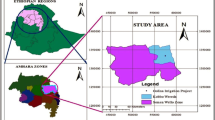Abstract
Field evaluation of surface irrigation systems play a fundamental role to determine the efficiency of the system as it is being used and to identify management practices and system configurations that can be implemented to improve the irrigation efficiency. This study evaluated the performance of an ‘improved’ traditional small-scale irrigation practice at Adada, a representative small-scale irrigation practice in Dire Dawa Administrative Council, Eastern Ethiopia. In order to determine numerical values of performance measures, certain parameters were measured/observed before, during and after an irrigation event while farmers are performing their normal irrigation practice. These parameters include: irrigated crop, irrigation method, stream size, cutoff time, soil moisture deficiency, and field size, shape and spacing. The results showed that the irrigation water applied to a farmer's plot during an irrigation event/turn was generally higher than the required depth to be applied per event. Since the irrigation method used was end-dyked, the major cause of water loss was due to deep percolation. The deep percolation loss was 32% in sorghum, 57% in maize, and 70% in tomato and potato fields. The type of irrigation system used, the ridged irrigation practice and the poor irrigation scheduling in the study sites were the main problems identified in the management and operations of the schemes. The following corrective measures are recommended to improve the system: (1) farmers should regulate the depth of irrigation water they apply according to the type of crop and its growth stage, change the field irrigation system and/or configuration especially for shallow rooted row crops, to furrow system, (2) guidance and support to farmers in developing and introduction of appropriate irrigation scheduling, and (3) future development interventions towards improvement of traditional irrigation practices should also focus in improving the on farm irrigation systems in addition to improving physical infrastructure of the scheme.
Similar content being viewed by others
References
Allen, R.G., Pereira, D., Raes, D. & Smith, M. 1998. Crop evapotranspiration. FAO Irrigation and Drainage Paper No 56, FAO, Rome.
DDAC. 2000. Dire Dawa Administrative Council Water Mines and Energy Office water sector review report. Dire Dawa, Ethiopia.
Faci, J.M., Bensaaci, A., Slatni, A. & Playan, E. 2000. A case study for modernization: Characterization of the district and analysis of water delivery records. Agricultural Water Management 42(I): 313–334.
Hart, W.E., Collins, H.G., Woodward, G. & Humpherys, A.S. 1983. Design and operation of gravity or surface systems. In: Design and Operation of Farm Irrigation Systems. ASAE Monograph.
Karmeli, D., Slazar, L.J. & Walker, W.R. 1978. Assessing the Spatial Variability of Irrigation Water Application. Oklahoma, USA.
Merriam, J.L., Shrarer, M.N. & Burt, C.M. 1983. Evaluating irrigation systems and practices. In: M.E. Jensen (Ed) Design and Operation of Farm Irrigation Systems (pp 721–760). ASAE, Monograph No. 3, St. Joseph, MI.
MoWR. 1998. EFDR Ministry of Water Resources water resources sector brief report (unpublished). Addis Ababa, Ethiopia.
Pereiera, L.S. 1996. Inter-relatioship between irrigation scheduling methods and on-farm irrigation systems. In: Irrigation Scheduling: From Theory to Practice. FAO Water Report No. 8, FAO, Rome.
Reddy, J.M. & Clyma, W. 1993. Surface Irrigation: Teaching Material. Institute for Land and Water Management, KU Leuven, Belgium.
Smith, M. 1992. A computer program for irrigation planning and management. FAO Irrigation and Drainage Paper No. 24, FAO, Rome.
Walker, W.R. 1989. Guidelines for designing and evaluating surface irrigation systems. FAO Irrigation and Drainage Paper No. 24, FAO, Rome.
Walker, W.R. & Skogerboe, G.V. 1987. Surface Irrigation. Theory and Practice. Prentice Hall Inc., Englewood Cliffs, NJ, USA.
Zerihun, D. & Feyen, J. 1996. Surface Irrigation System. Institute for Land and Water Managemnt, Katholike Universiteit Leuven, Belgium.
Author information
Authors and Affiliations
Corresponding author
Rights and permissions
About this article
Cite this article
Bekele, Z., Tilahun, K. On-farm performance evaluation of improved traditional small-scale irrigation practices: A case study from Dire Dawa area, Ethiopia. Irrig Drainage Syst 20, 83–98 (2006). https://doi.org/10.1007/s10795-006-5754-y
Issue Date:
DOI: https://doi.org/10.1007/s10795-006-5754-y




